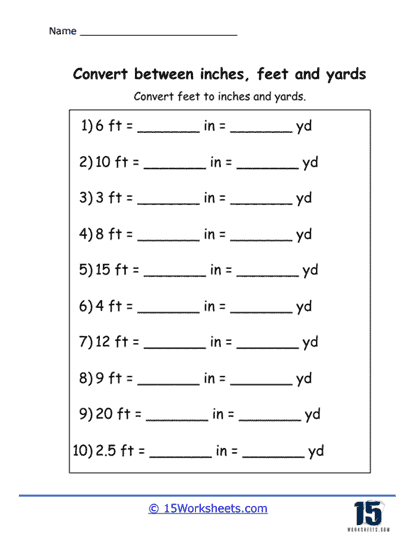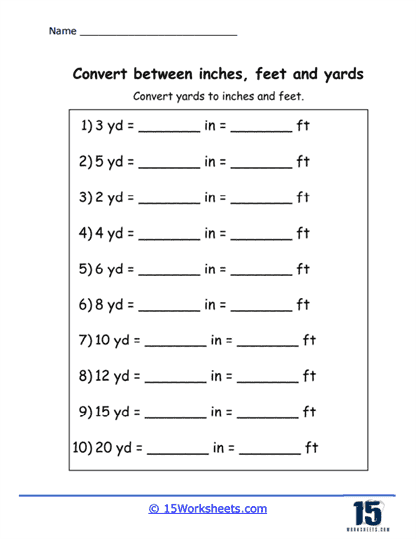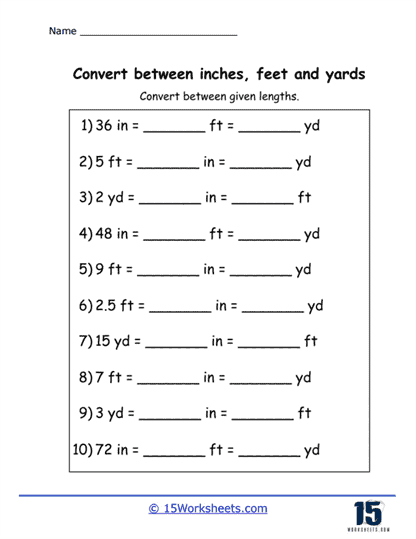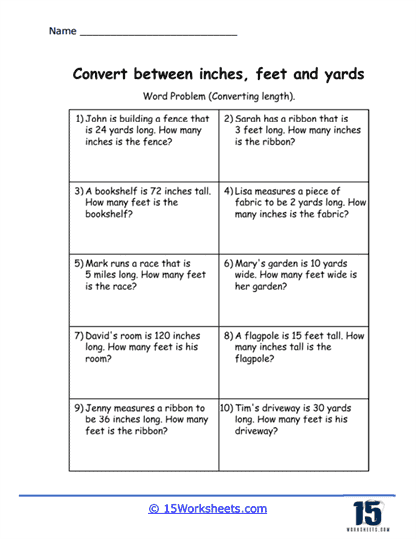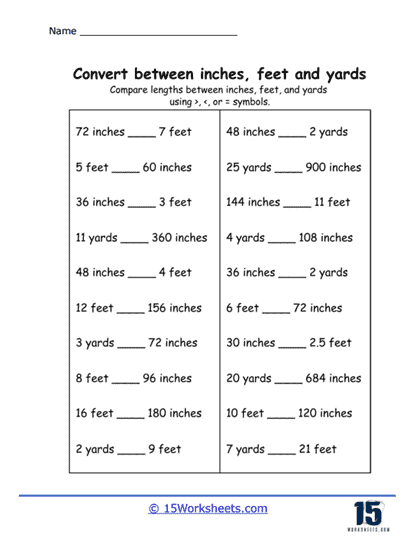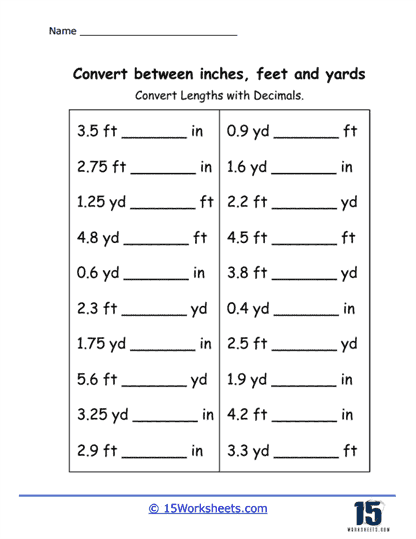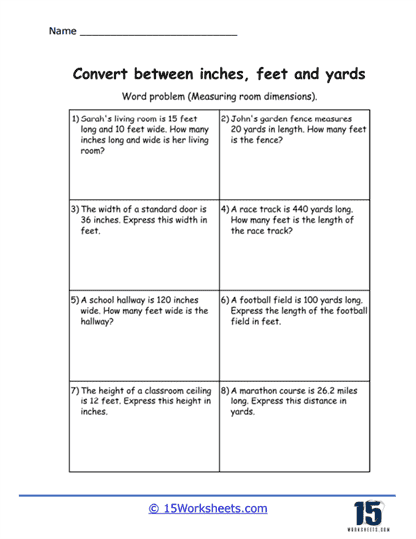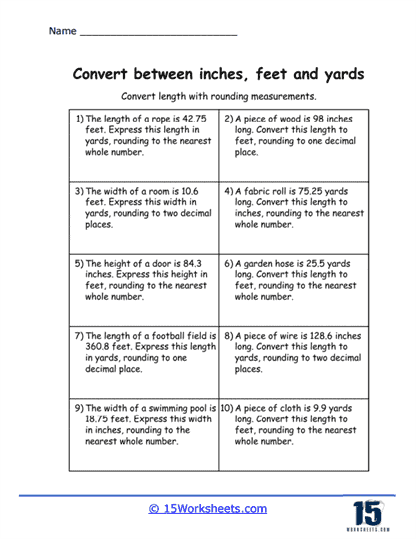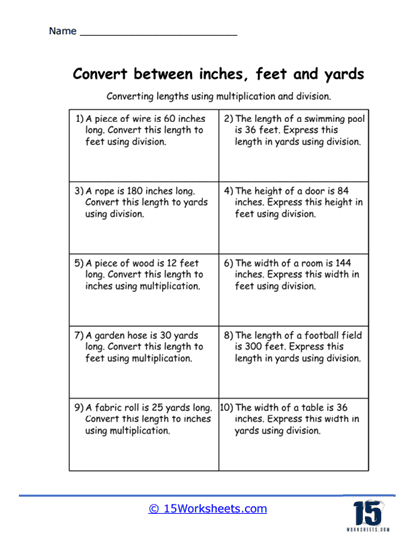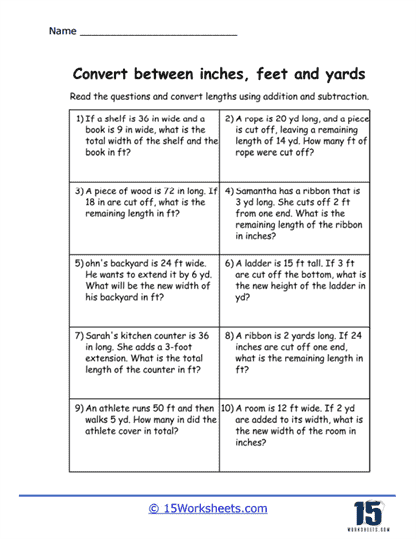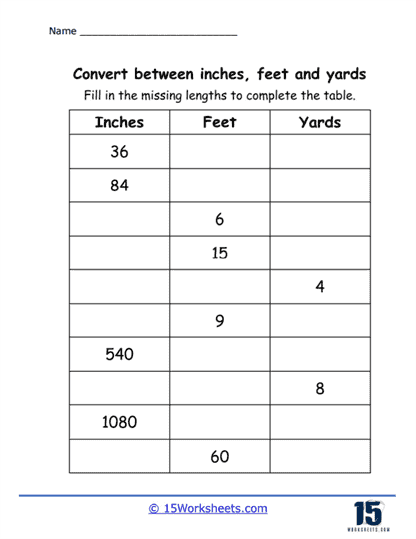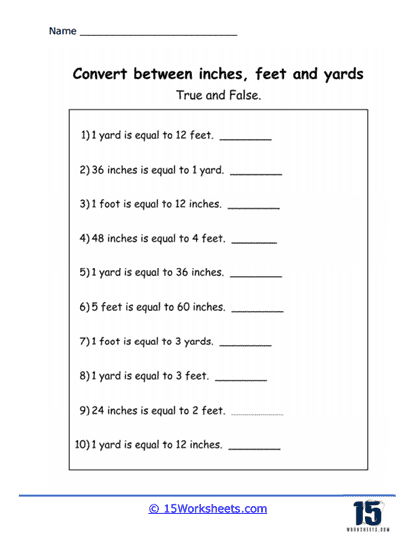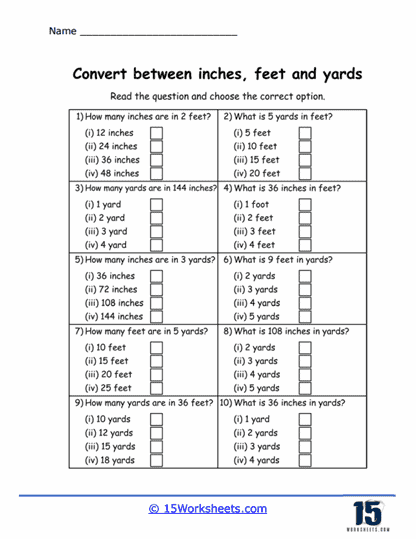Inches, Feet, and Yards Worksheets
About These 15 Worksheets
These worksheets were designed to teach and reinforce the understanding and application of the U.S. customary units of length. These units-inch, foot, and yard-are commonly used in the United States for a variety of purposes ranging from construction to everyday measurements. By using these worksheets, students learn to perform conversions between these units, solve problems that involve measuring lengths, and apply their knowledge in real-world scenarios. These worksheets are tailored to build foundational skills in measurement, critical for students in elementary through middle school, and even beyond in certain contexts.
These worksheets not only teach fundamental measurement skills but also apply these skills in various contexts, preparing students for more complex mathematical concepts and real-life applications. Through structured practice and diverse activities, students become proficient in using and converting inches, feet, and yards, skills that are indispensable in both their academic journey and everyday life.
Conversion Exercises
One of the core components of inches, feet, and yards worksheets are the conversion exercises. These exercises require students to convert measurements from one unit to another, such as converting inches to feet, feet to yards, or even between all three. For example, a problem might ask how many inches are in 5 feet or how many feet are in 3 yards. These conversions are fundamental, as they strengthen understanding of the relationships between different units of measurement. Students learn to use multiplication or division to convert measurements up or down the scale, enhancing their numerical fluency and reinforcing the practical use of multiplication tables in real-world contexts.
Measurement Activities
Measurement activities in these worksheets involve using rulers, yardsticks, or tape measures to measure the length of various objects. This type of exercise might ask students to measure the length of their desk, a book, or any other item accessible during the lesson. Additionally, these activities can be extended to measuring the perimeter of simple shapes drawn on paper or even the classroom itself. Through these exercises, students not only practice using measurement tools but also gain a tangible understanding of the length units and their practical relevance in everyday life.
Word Problems
Word problems combine measurement concepts with real-world scenarios, requiring students to apply their knowledge to solve problems. These might include situations such as determining the total length of a fence needed to encircle a garden or calculating the length of material required to complete a craft project. By solving word problems, students enhance their problem-solving skills and mathematical reasoning. They also learn how to interpret a scenario and extract necessary information, a skill that is invaluable across all areas of math and science.
Estimation Exercises
Estimation exercises challenge students to make educated guesses about measurements before actually measuring. For instance, students might estimate the length of a classroom window, then measure it to see how close their estimation was. These exercises develop critical thinking and help students get a practical sense of distance and measurement. Estimation also encourages mental math practice, as students learn to approximate and adjust their guesses based on real measurements.
Matching and Sorting Activities
These activities often involve matching objects to their respective lengths or sorting a set of items based on their length. For example, a worksheet might have pictures of a pencil, a shoe, and a bed, asking students to match these items with their approximate lengths in inches, feet, or yards. Sorting might involve arranging a series of lines or objects from shortest to longest. Such exercises help students visually discriminate between different lengths and reinforce their understanding of measurement units.
In drawing and labeling exercises, students might be tasked with drawing lines or shapes of specific measurements. They could draw a line that is exactly 6 inches long or a rectangle that measures 3 feet by 1 yard. After drawing, students label the lengths using the appropriate units. This not only practices their measurement skills but also integrates some elements of geometry, enhancing their spatial awareness and precision.
Comparative Questions
Comparative questions ask students to compare lengths and use terms like “longer than,” “shorter than,” or “equal to.” These might be formatted as multiple-choice questions or fill-in-the-blanks. For example, a problem might ask whether a 36-inch yardstick is longer than 1 yard. These exercises reinforce understanding of measurement equivalence and comparative assessment, which are crucial for making informed judgments in practical tasks.
When Do We Use These Units In The Real World?
In the real world, the measurement units of inches, feet, and yards are essential across a broad spectrum of activities, industries, and daily tasks. These units are part of the U.S. customary system, and their usage is ingrained in the fabric of everyday life in the United States as well as in other countries that utilize similar measurement systems. The versatility and range of applications of these measurements ensure their continued relevance and importance.
Construction and Engineering
One of the most prevalent uses of inches, feet, and yards is in the field of construction and engineering. These units are fundamental in designing and building structures. From the initial blueprints to the final touches, every phase of construction relies on accurate measurements. Architects and engineers use feet and yards to draft plans for new buildings, ensuring rooms have the correct dimensions and the overall layout is structurally sound. In carpentry, inches are commonly used to provide precise measurements for cuts, joins, and fittings. The use of inches allows for a high degree of accuracy necessary for the quality and safety of building projects.
Manufacturing
In manufacturing, especially in the production of furniture, appliances, and other household items, inches and feet are commonly used to ensure that products conform to standard sizes. Whether it’s the length of a sofa, the size of appliances, or the dimensions of cabinets, using inches and feet helps manufacturers create products that fit well in the living spaces they are designed for. Additionally, these units are crucial in quality control, ensuring that each component fits with others to precise specifications.
Textiles and Crafting
In textiles, yards are predominantly used to measure fabric lengths. Whether for fashion design or upholstery, yards provide an easy quantity for vendors to cut and sell fabric. Similarly, in crafts and interior decorating, inches and feet are used to measure and cut materials to fit specific designs or spaces. These measurements ensure that the materials will be sufficient and proportionate for the intended project, enhancing both the aesthetics and functionality of crafted items.
Sports and Recreation
In the sports arena, feet and yards play a crucial role in setting up and understanding the playing fields and rules. For example, football fields in the United States are measured in yards, from the total length of the field to the smaller increments used to regulate play. Track and field events often use feet and yards to mark distances for races and other competitions. These measurements are integral to the fairness and standardization of sports competitions.
Retail and Commerce
In retail, inches and feet are used to describe the dimensions of products, giving consumers a clear idea of the size of the items they purchase. This is crucial in sectors such as home furnishings, where customers need to know if a piece of furniture will fit in their designated space. Yards may also be used in garden centers for items sold by linear measurements, such as fencing or fabric.
Everyday Use
On a more day-to-day basis, inches, feet, and yards are used by the general public for numerous tasks such as home improvement, gardening, and personal projects. Whether measuring for curtains, determining the amount of paint needed for a wall, or setting up a garden layout, these units make it possible to achieve precise results that fit the intended space or purpose.


